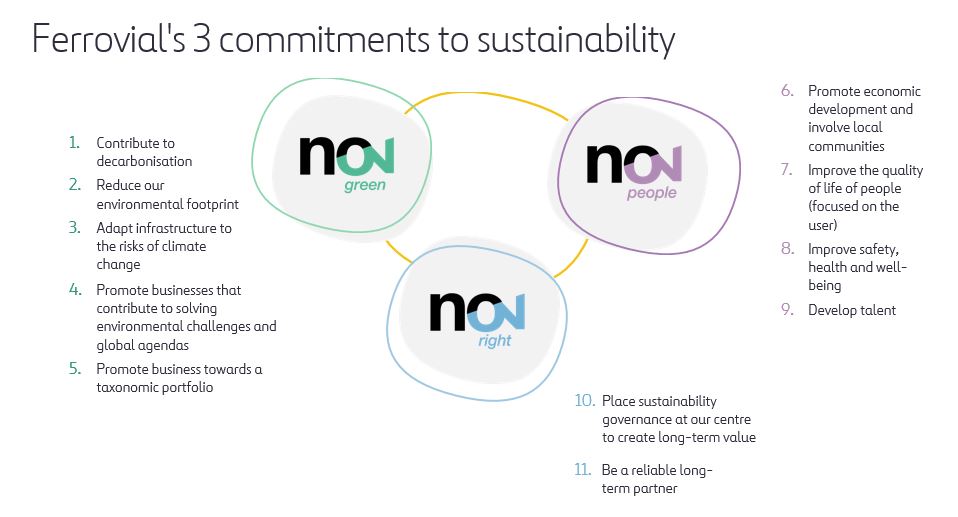Each project and asset is legally independent and has its own managers.
2030 Sustainability Strategy
Respect for the environment and striving to support responsible social development are behind all of our actions and our commitments. Our strategy is linked to the Sustainable Development Goals (SDGs) put forth by the UN to make the world a better place by 2030.
This strategy is also a tool for generating and identifying new business opportunities where we can stand out as an innovative, committed company. For years, strategic plans have acted as the company’s core axes, favoring business growth and supporting decision-making in a world that never stops turning.
DOWNLOAD HERE OUR SUSTAINABILITY STRATEGYIn recognition of our responsibility to deliver efficient and sustainable infrastructure that
adds value for our stakeholders, enhances the natural environment, and delivers
lasting positive local, we have launched our Social Value Strategy for the UK Construction business. Forming part of our UK Construction Sustainability Strategy, this document outlines our ambitions and targets to deliver positive social, economic, and environmental impact at a local and national level across our Ferrovial Construction projects in the UK.
2030 Sustainability Strategy
Infrastructure is a key tool for driving the development of people and communities. For over 70 years, we have contributed to society by designing, building, and operating sustainable infrastructure that advances communities and protects the environment with our own way- the Ferrovial way.
A world on the move challenges us to adapt our way of doing things to be mindful of the environment. Based on experience and knowledge, at Ferrovial, always one step ahead, we embark on businesses in the only way we understand to be right – with integrity and transparency, respecting people and the planet, multiplying our contribution through collaboration with our stakeholders.
This is something we already promote in the activity we maintain around the world, in every corner of the globe where Ferrovial operates. A commitment that evolves and prepares for future horizons. That’s why Now is born.

ESG criteria: environment, social, and governance
To face the current challenges, the 2030 Sustainability Strategy offers guidelines for developing innovative, efficient, and sustainable infrastructure, all which are based on ESG criteria and constituted by three main pillars: environmental, social, and governance.
Environment: our commitment to the environment is leading us to reduce our carbon footprint and support sustainable approaches in all of our operations. These criteria define the strategy in environmental matters:
- 2030 climate strategy: in order to comply with the Paris Agreement and the 2030 Agenda, our strategy has a roadmap with ambitious emissions reduction objectives set for 2030 and 2050, aligned with the Science Based Targets initiative (SBTi).
- Water footprint: our purposes include offsetting our water footprint annually and reducing business water index by 20% by 2030, considering 2017 as the base year.
- Natural Capital: we recognize the key role that natural capital and biodiversity play in the provision of services that support the economy and social well-being and that is why we have a Biodiversity policy and are aligning with the Taskforce on Nature-related Financial Disclosures (TNFD).
- Circular economy: our Circular Economy Plan establishes the guidelines for waste management and the efficient use of materials, following the principles of the circular economy in our processes.
Social: at a social level, we focus on initiatives that attract and motivate talent while supporting ethical behavior.
- Local talent: with the aim of expanding the pool of global and local talent.
- Health and wellness: ensuring healthy work environments for all employees, regardless of their job title or location
- Occupational safety: this goal aims to reduce occupational accidents continually and progressively
- Investing in the community: developing sustainable infrastructure and being active agents in addressing health and social problems
Governance: having good governance is essential to ensuring transparency and good practices. These criteria define the strategy:
- Good governance: we have guidelines such as our Code of Business Ethics and the Compliance Program
- Sustainability in governance: we ensure this with instruments like the Sustainability Steering Committee, which reports to the Board of Directors
- Supply chain: we integrate ESG principles in the supply chain, through a Supplier Code of Ethics that we have developed to extend our performance guidelines in accordance with ethics, integrity, respect for legality, transparency health and safety, environmental commitment and respect for human rights.
